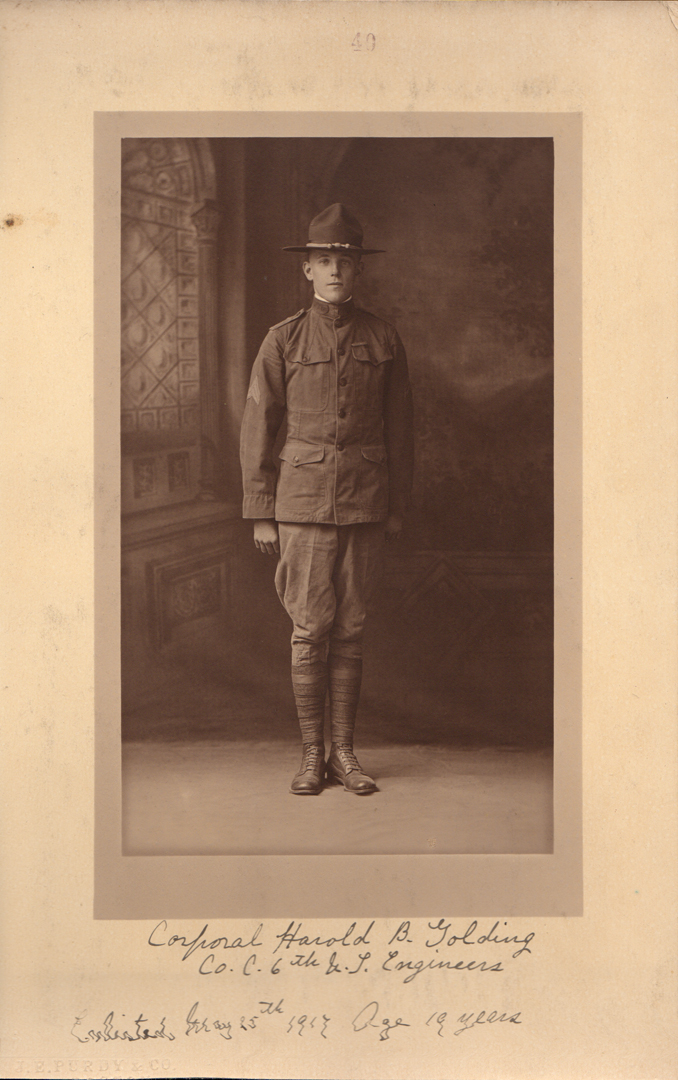Dorchester Illustration World War One Service Member biography: Harold Bertram Golding
At the Dorchester Historical Society, we are in the process of a year-long project to commemorate the 100th anniversary of World War I. Using a collection of photographs we have of WWI Dorchester residents, we will be featuring servicemen in a number of short biographies throughout the year. At the culmination of the project, we hope to produce an online exhibit that highlights these men and their service to our country.
Our next biography features: Harold Bertram Golding.
Written by Camille Arbogast.
Harold Bertram Golding was born in St. John, New Brunswick, on March 28, 1898, the son of machinist George Edgar Golding and his wife, Lena. Harold’s sister, Myrtle, was born two years later. The family immigrated to the United States around 1902. They settled in Dorchester, at 24 Mountain Avenue, where Harold’s youngest sister Edith was born in 1908. Harold graduated from Dorchester High School.
By 1917, the family had moved to 54 Rockwell Street. On May 25, at age 19, Harold enlisted at Fort Slocum in New Rochelle, New York. He served in Company C, 6th Engineers. Shortly before enlisting, he began the process of becoming an American citizen.
On December 4, 1917, he sailed for France from Hoboken, New Jersey, on the USS George Washington. He participated in engagements at Aisne-Marne, Champagne-Marne, and Saint-Mihiel. During the Meuse-Argonne Offensive in October 1918, he distinguished himself at Bois de Clair Chenes. His Recommendation for Divisional Citation noted, “Pvt, 1st Class, Golding rendered faithful and efficient service as a runner to the front line, continuing this work ten days after his company had been relieved from the front line as Infantry. He constantly exposed himself and was undeterred by heavy shell and the machine gun fire from enemy snipers.” On November 11, 1918, he was made a Corporal.
He returned to the United States in August, 1919, sailing from Brest on the USS Manchuria, and arriving in Hoboken on August 25. On September 2, 1919 he was naturalized as an American citizen; he was discharged the next day.
In 1920, his family resided at 83 Standard Street in Mattapan. Harold entered the Massachusetts Institute of Technology in the Department of Mechanical Engineering, and graduated with the class of 1923. While a student, he co-authored the dissertation “Erosion Test on Valve and Turbine Metals.”
In the late 1920s, Harold and his parents left Dorchester. After a short time in West Roxbury, they purchased a home in Dedham. In 1930, Harold was working as a mechanical engineer at a surgical instruments manufacturer; his father worked there, too, as a machinist. The manufacturer was probably International Equipment Company, where Harold reported working in 1940. He continued with the company for the rest of his life, eventually becoming the vice-president. Located in Brighton, International Equipment was well known for its centrifuges. In 1950, Harold contributed the chapter “Centrifuging,” in Volume III of the textbook Techniques of Organic Chemistry.
Harold was an active member of the Boston Skating Club, serving in many roles, including treasurer and head of the Equipment Committee. In 1953, Harold travelled to Central America with a friend from the club, George Blodgett. Both men were pilots, and they flew in Blodgett’s Cessna 180 airplane. Their ultimate destination was Lima, Peru. On July 17, they traveled from Guatemala City to Managua, Nicaragua, to refuel their plane. They then departed for San Jose, Costa Rica, but their plane never arrived. The Nicaraguan Air Force conducted an extensive search for the downed plane for three days but never found the plane. The President of Nicaragua, Anastacio Somoza, even personally conducted some of the search.. By March,1954, any hope of finding Harold and George was abandoned and a memorial service for both men was held at the First Congregational Church in Cambridge.
Sources
Provincial Archives of New Brunswick, Index to County Birth Registers; archives.gnb.ca
Government of Canada, 1901 Census, Ottawa, ON: Library and Archives Canada, 1901; bac-lac.gc.ca
Naturalization Records. National Archives at Boston, Waltham, Massachusetts; Ancestry.com
Birth record for Edith Golding, Birth Certificate, Massachusetts Vital Records, 1840–1911. New England Historic Genealogical Society, Boston, Massachusetts; Ancestry.com
Census Records, Federal, 1910, 1920, 1930, 1940; Ancestry.com
Service Record; The Adjutant General Office, Archives-Museum Branch, Concord, MA
The History of the 6th Engineers by Its Men. NY: Knickerbocker Press, 1920, pg 222; google books
Lists of Outgoing Passengers, 1917-1938 & Lists of Incoming Passengers, 1917-1938, Records of the Office of the Quartermaster General, 1774-1985, The National Archives at College Park, Maryland; Ancestry.com
Massachusetts Institute of Technology Technique 1924, page 68; technique.mit.edu/archive/
Golding, Harold B. “Centrifuging,” Technique of Organic Chemistry, Vol III. NY: Intersciences Publishers, Inc, 1950, pgs vii, 143-170
Boston Directories, various years; Ancestry.com
“Plane Wreck Sighted in Panama Spurs Hope for Cambridge Men” Boston Globe. 29 July 1953: 13
“Search Pushed for Bay Staters Lost on Plane” Boston Globe. 30 July 1953:9
“Memorial to be Held Saturday for Blodgett, Golding” Boston Globe. 17 March 1954: 23

